
Journal Basic Info
- Impact Factor: 1.809**
- H-Index: 6
- ISSN: 2474-1655
- DOI: 10.25107/2474-1655
Major Scope
- Child Birth
- Sexual Health
- Nursing
- Obstetrics and Gynecology
- Surgery Cases
- Veterinary Sciences
- Cancer Clinic
- Biochemistry and Biostatistics
Abstract
Citation: Ann Clin Case Rep. 2022;7(1):2239.DOI: 10.25107/2474-1655.2239
Risky Sexual Practice, Unintended Pregnancy, Contraceptive Utilization, and Its Determinants among HIV-Infected Women in Oromia Regional State, Ethiopia
Demissie DB1* and Mmusi-Phetoe R2
1Department of Health Studies, College of Human Science, University of South Africa, Regional Learning Office Ethiopia, and St. Paul’s Hospital Millennium Medical College, Ethiopia 2Department of Public Health, College of Human Science, University of South Africa, South Africa
*Correspondance to: Dereje Bayissa Demissie
PDF Full Text Research Article | Open Access
Abstract:
Objectives: The purpose of this study was to determine the prevalence of risky sexual practice, unintended pregnancy, contraceptive utilization, and its determinants among women of reproductive age in Oromia, Ethiopia. Methods: Health facility-based cross-sectional study design was conducted among women living with HIV attending ART clinics in the special zone of, Oromia Regional state, by simple random sampling was used to select 654 respondents. Both bivariate and multivariable logistic regressions analysis was used to identify at Adjusted Odds Ratio (AOR) with 95% CI in the final model. Result: The current family planning utilization among women of reproductive age living with HIV in Oromia Region was 548 (83.8%). The completed response rate of this study was 97.6% (654/670). There were 654 respondents whose ages ranged between 18 and 49 years. The prevalence of dual contraceptive utilization was 425 (73.8%), of which 343 (80.7%) and 306 (72%) were sustained users of dual contraception methods, respectively. Open discussion on family planning with healthcare providers and having received family planning counseling about the efficacy of each method were assumed to be contributing factors. Conclusion: The current family planning utilization among women of reproductive age was higher than the national contraceptive prevalence rate. This proportion is parallel to the proportion of service providers reporting to provide both HIV- and family planning-related services as being largely dependent on training on integrated family planning and HIV services.
Keywords:
Cite the Article:
Demissie DB, Mmusi-Phetoe R. Risky Sexual Practice, Unintended Pregnancy, Contraceptive Utilization, and Its Determinants among HIVInfected Women in Oromia Regional State, Ethiopia. Ann Clin Case Rep. 2022; 7: 2239.













